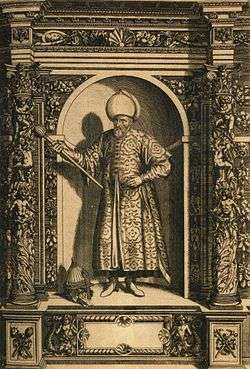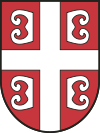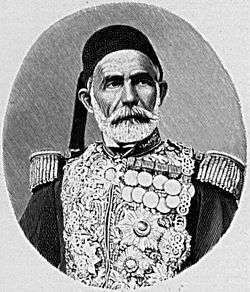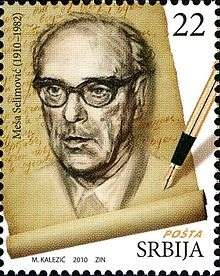Serb Muslims

| Part of a series of articles on |
| Serbs |
|---|
 |
|
Native communities |
|
Related groups |
The term Serb Muslims (Serbian: Срби муслимани / Srbi muslimani) refers to ethnic Serbs who are Muslims (adherents of Islam) by their religious affiliation. Since it is defined by ethnicity and religion, term Serb Muslims should not be confused with term Serbian Muslims that refers generally to all adherents of Islam in Serbia, regardless of their ethnicity (See: Islam in Serbia).
Use of the term
The term has several particular uses:
- In ethnographic, historical and comparative religious studies it is used as a designation for Islamized families of ethnic Serb descent.
- It has been used as a self-identification (Srbi-muhamedanci, Srbi-muslimani) in former Yugoslavia.
- It is used in historical studies to identify Ottoman people of Serb origin.
- It is used for the Muslim population in the region of Sandžak (Serbia).[1]
- It has been historically used by Serbian nationalists for the Slavic-speaking Muslim populations of Bosnia and Herzegovina (Bosniaks), Sandžak (Bosniaks and Muslims by ethnicity), and Kosovo (Bosniaks, Muslims by ethnicity and Goranci).
History

Since Serbs were, and still are, predominantly Eastern Orthodox Christians, their first significant historical encounter with Islam occurred in the second half of 14th century, and was marked by Turkish invasion and conquest of Serbian lands (starting in 1371 and ending by the beginning of 16th century). That interval was marked by first wave of Islamization among Serbs: in some regions, substantial minority left Christianity and converted into Islam, willingly or by necessity, under the influence of Ottoman authorities. The most notable Muslim of Serb ethnicity was Mehmed-paša Sokolović (1506-1579), Grand Vizier of the Ottoman Empire (1565-1579), who was ethnic Serb by birth, and so was Omar Pasha Latas.
Kingdom of Yugoslavia
Gajret
Gajret (known as Serbian Muslim Cultural Society after 1929) was a cultural society established in 1903 that promoted Serbian identity among the Slavic Muslims of Austria-Hungary (today's Bosnia and Herzegovina).[2] The organization viewed that the Muslims were Serbs lacking ethnic consciousness.[3] The view that Muslims were Serbs is probably the oldest of three ethnic theories among the Bosnian Muslims themselves.[4] It was dismantled by the Independent State of Croatia during World War II.[5] Some members, non-Communists, joined or collaborated with the Yugoslav Partisans, while others joined the Chetniks.
World War I
Muslims joined the Serbian army in World War I. The majority were Muslims who had a Serb identity, declaring as Serbs.[6] Among notable soldiers were Avdo Hasanbegović, Šukrija Kurtović, Ibrahim Hadžimerović, Fehim Musakadić, Hamid Kukić, Rešid Kurtagić, who all fought as Serbian volunteer officers at the Salonica Front.[7] Among the most active in the group of Muslims who were engaged in Yugoslav propaganda on Austro-Hungarian Muslim POWs were A. Hasanbegović, Azis Sarić, F. Musakadić, Alija Džemidžić, R. Kurtagić, Asim Šeremeta, Hamid Kukić and Ibrahim Hadžiomerović.[8]
World War II
During World War II in Yugoslavia, few Muslims joined the Chetniks. These espoused a Serb ethnic identity. The most notable of these was Ismet Popovac, who commanded the Muslim National Military Organization (Muslimanska narodna vojna organizacija, MNVO). The resolution of MNVO states that "Muslims are an integral part of Serbdom".[9] World War I veteran Fehim Musakadić also joined the Chetniks.[10]
SFR Yugoslavia

In the 1948 census, Muslims in Yugoslavia were allowed to declare as "Serb-Muslims", "Croat-Muslims" or "Undetermined" Muslims,[11] the overwhelming majority choosing the option undetermined.[12]
Some prominent Muslims in Yugoslavia openly declared as Serbs, such as writer Meša Selimović.[13]
Yugoslav Wars
During early talks of the partition of Bosnia and Herzegovina, Ejup Ganić remarked that the Bosniaks "are Islamized Serbs", and should thus join the Serb side, at a time when the SDA shifted in favour of siding with the Serbs and continuing struggling against the Croats.[14] Political analyst Jochen Hippler noted in 1994 that "Muslims are mostly ethnically Serb, a minority Croat, but this did not save them from being slaughtered by their fellow ethnic groups for being different."[15]
Serb nationalists usually insisted that Bosnian Muslims were Serbs that had abandoned their faith.[16] Serbian historiography emphasizes an Orthodox Serbian origin for the Bosniaks who are interpreted as relinquishing ties to that ethno-religious heritage after converting to Islam and later denying it by refusing to accept a Serbian identity.[17][18] Bosnian Muslims within the bulk of Serbian nationalist historiography are presented as the descendants of the mentally ill, lazy, slaves, greedy landlords, prisoners, thieves, outcasts or as Serbs who confused and defeated chose to follow their enemies religion.[19]
Censuses
Serbian censuses
In the 2014 census in Serbia, of those who declared as ethnic Serbs, 0.04% (2,816) declared Islam as their religion .[20]
Notable people
- Avdo Karabegović (1878–1908), Bosnian writer [21]
- Osman Đikić (1879–1912), Bosnian writer [21]
- Muhamed Mehmedbašić (1886–1943), Bosnian revolutionary [22]
- Mustafa Golubić (1889–1941), Chetnik [23]
- Hasan Rebac, writer
- Ismet Popovac (d. 1943), World War II Chetnik
- Fehim Musakadić (d. 1943), World War I Serbian soldier and World War II Chetnik
- Meša Selimović (1910–1982), Yugoslav writer
- Emir Kusturica (b. 1954), Serbian filmmaker
See also
References
- ↑ Jørgen Schøler Nielsen; Samim Akgönül; Ahmet Alibašić; Brigitte Maréchal; Christian Moe (2009). Yearbook of Muslims in Europe. BRILL. pp. 213–. ISBN 90-04-17505-9.
and it is mainly frequented by Serb Muslims from Sandjak.
- ↑ Allworth 1994, p. 125.
- ↑ Allworth 1994, p. 126.
- ↑ Allworth 1994, p. 116.
- ↑ Emily Greble (2011). Sarajevo 1941–1945: Muslims, Christians, and Jews in Hitler's Europe. Cornell University Press. pp. 121–. ISBN 0-8014-6121-9.
- ↑ Драга Мастиловић (2009). Херцеговина у Краљевини Срба, Хрвата и Словенаца: 1918-1929. Филип Вишњић. p. 48. ISBN 978-86-7363-604-7.
- ↑ Mustafa A. Mulalić (1936). Orijent na zapadu: savremeni kulturni i socijalni problemi Muslimana Jugoslovena. Skerlić. p. 172.
- ↑ Istorijski glasnik: organ Društva istoričara SR Srbije. Društvo. 1980. p. 113.
- ↑ Enver Redzic; Robert Donia (13 December 2004). Bosnia and Herzegovina in the Second World War. Routledge. p. 153. ISBN 978-1-135-76736-5.
- ↑ Prilozi. 20. Institut za istoriju. 1984. p. 100.
- ↑ Francine Friedman (1996). The Bosnian Muslims: denial of a nation. Westview Press. ISBN 978-0-8133-2097-7.
Promoting that policy, in the 1948 census the Bosnian Muslims were permitted to declare themselves as Serb- Muslims, Croat- Muslims, or nationally "undetermined" Muslims, revealing the stance of Communist leaders that held that Muslims ...
- ↑ Philip Emil Muehlenbeck, ed. (2012). Religion and the Cold War: A Global Perspective. Vanderbilt University Press. p. 184.
- ↑ Trbovich 2008, p. 100.
- ↑ Steven L. Burg; Paul S. Shoup (4 March 2015). Ethnic Conflict and International Intervention: Crisis in Bosnia-Herzegovina, 1990-93: Crisis in Bosnia-Herzegovina, 1990-93. Taylor & Francis. p. 341. ISBN 978-1-317-47101-1.
- ↑ Jochen Hippler (1 April 1994). Pax Americana?: hegemony or decline. Pluto Press. p. 164. ISBN 978-0-7453-0695-7.
- ↑ Emran Qureshi; Michael A. Sells (5 November 2003). The New Crusades: Constructing the Muslim Enemy. Columbia University Press. pp. 323–. ISBN 978-0-231-50156-9.
- ↑ Bieber, Florian (2006). Post-War Bosnia: Ethnicity, Inequality and Public Sector Governance. Palgrave Macmillan. p. 5. ISBN 978-0-230-50137-9.
- ↑ Mekić, Sejad (2016). A Muslim Reformist in Communist Yugoslavia: The Life and Thought of Husein Đozo. Routledge. p. 17. ISBN 978-0-230-50137-9.
- ↑ Alibašić, Ahmet (2014). "Bosnia and Herzegovina". In Cesari, Jocelyne. The Oxford Handbook of European Islam. Oxford: Oxford University Press. p. 431. ISBN 978-0-19-102640-9.
- ↑ Government of Serbia 2014, p. 194.
- 1 2 Stanoje Stanojević; Jovan Jovanović; Slobodan Jovanović; Nikola Stojanović. Srpski narod u XIX veku. 15. Geca Kon. p. 90.
- ↑ Alija S. Konjhodžić (1974). Spomenica Bratstva: 1954-1974. p. 381.
- ↑ Vojska. 11. Vojnoizdavački i novinski centar. 2002. p. 175.
Sources
- Allworth, Edward (1994). Muslim Communities Reemerge: Historical Perspectives on Nationality, Politics, and Opposition in the Former Soviet Union and Yugoslavia. Duke University Press. ISBN 0-8223-1490-8.
- Вукићевић, Миленко M. (1901). Знаменити Срби мухамеданци (Prominent Serb Muhamedans). Београд.
- Вукићевић, Миленко M. (1906). Знаменити Срби мусломани (Prominent Serb Muslims). Београд: Српска књижевна задруга.
- Вукићевић, Миленко M. (1998). Знаменити Срби муслимани (Prominent Serb Muslims). Београд: ННК.
- Раковић, Александар (2016). "Српски идентитет муслимана словенског порекла на постјугословенском простору у 21. веку (The Serb identity of Muslims of Slavic origin on post-Yugoslav space in the 21st century)" (PDF). Култура полиса: Часопис за неговање демократске политичке културе. 13 (31): 171–183.
- Republički zavod za statistiku Srbije (2014). "Etnomozaik" (PDF). Belgrade: Republički zavod za statistiku Srbije.
- Trbovich, Ana S. (2008). A Legal Geography of Yugoslavia's Disintegration. Oxford University Press, USA. pp. 100–. ISBN 978-0-19-533343-5.
Further reading
- Lazo M. Kostić (1967). Nauka utvrduje narodnost B-X Muslimana.